当代物流学习题3
- 格式:doc
- 大小:130.00 KB
- 文档页数:11
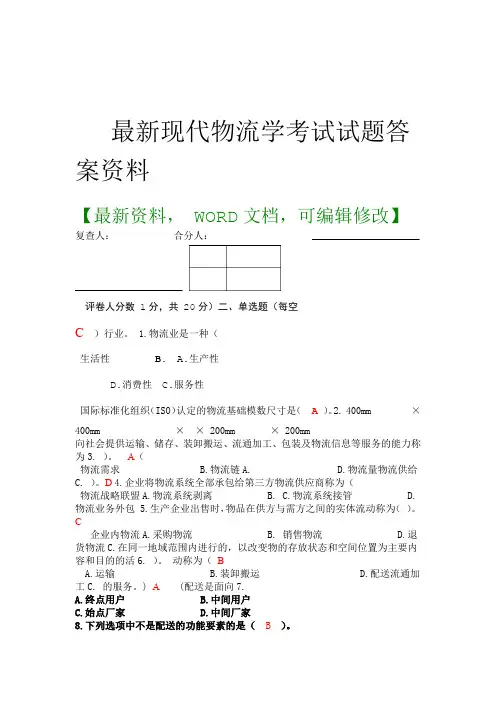
最新现代物流学考试试题答案资料【最新资料, WORD文档,可编辑修改】复查人:合分人:评卷人分数 1分,共 20分)二、单选题(每空C)行业。
1.物流业是一种(生活性 B. A.生产性D.消费性 C.服务性国际标准化组织(ISO)认定的物流基础模数尺寸是( A )。
2. 400mm ×400mm ×× 200mm × 200mm向社会提供运输、储存、装卸搬运、流通加工、包装及物流信息等服务的能力称为3. )。
A(物流需求 B.物流链A. D.物流量物流供给C. )。
D 4.企业将物流系统全部承包给第三方物流供应商称为(物流战略联盟A.物流系统剥离 B. C.物流系统接管 D.物流业务外包 5.生产企业出售时,物品在供方与需方之间的实体流动称为()。
C企业内物流A.采购物流 B. 销售物流 D.退货物流C.在同一地域范围内进行的,以改变物的存放状态和空间位置为主要内容和目的的活6. )。
动称为( BA.运输B.装卸搬运 D.配送流通加工C. 的服务。
) A (配送是面向7.A.终点用户B.中间用户C.始点厂家D.中间厂家8.下列选项中不是配送的功能要素的是(B)。
A.送货B.包装C.分拣D.配货9.不属于物流增值服务功能的是(C)。
A.加快反应速度B.业务延伸C.订货D.增加便利性10.下列表述中不属于物流信息特点的是(C )。
A.物流信息种类多B.物流信息动态性强C.物流信息对提高经济效益起着非常重要的作用D.物流信息量大﹑分布广11.物流运输增值的时间效用表现为通过物品流通过程中的劳动克服了物品( C )时间上的不一致。
A.生产B.消费C.生产和消费D.采购12.最具灵活性的运输方式是( A )。
A.公路运输B.铁路运输C.航空运输D.远洋运输13.不适合航空运输货物的是( D )。
A.高附加值产品B.紧急救援物资C.生鲜食品D.大宗低值物品14.( A ) 是指将部分废旧物料通过收集、分类、加工、供应等环节转化成新的产品,重新投入到生产或消费领域的过程。
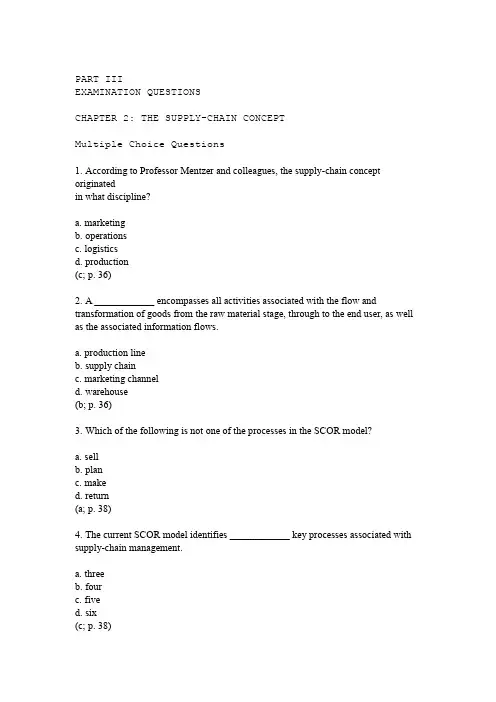
PART IIIEXAMINATION QUESTIONSCHAPTER 2: THE SUPPLY-CHAIN CONCEPTMultiple Choice Questions1.According to Professor Mentzer and colleagues, the supply-chain concept originatedin what discipline?a.marketingb.operationsc.logisticsd.production(c; p. 36)2.A ____________ encompasses all activities associated with the flow and transformation of goods from the raw material stage, through to the end user, as well as the associated information flows.a.production lineb.supply chainc.marketing channeld.warehouse(b; p. 36)3.Which of the following is not one of the processes in the SCOR model?a.sellb.planc.maked.return(a; p. 38)4.The current SCOR model identifies ____________ key processes associated with supply-chain management.a.threeb.fourc.fived.six(c; p. 38)5.The text suggests that logistics has an important role in all SCOR processes except:a.makeb.sourcec.deliverd.plan(d; p. 38)6.It has been suggested that company-versus-company competition might be superseded in the twenty-first century by:a.region-to-regionb.country-to-countryc.industry-to-industryd.supply chain-to-supply chain(d; p. 39)7.Which of the following are not key attributes of supply-chain management?a.inventory controlb.leveraging technologyc.customer powerd.a long-term orientatione.all are key attributes(e; p. 39)8.Contemporary supply chains should be fast and ____________.a.leanb.agilec.interactived.relevant(b; p. 40)9.An organization's ability to respond to changes in demand with respect to volume andvariety refers to ____.a.responsivenessb.leannessc.agilityd.relevancy(c; p. 40)10.Which of the following is not associated with relational exchanges?a.independenceb.trustmitmentd.shared benefits(a; p. 40)11.According to the text, ____________ has been at the center of the changes taking place that affect the supply chain.a.logisticsb.warehousingc.technologyd.customer power(c; p. 41)12.What has been referred to as the greatest force of commodization known to man, forboth goods and services?a.McDonald'sb.The Internetc.Wal-Martd.Logistics(b; p. 41)13.The two key factors that have sparked much of the technological change affecting supply chains are ____________ and ____________.a.EDI, ERPputing power, ERPc.EDI, Internetputing power, Internet(d; p. 41)14.The bullwhip effect:a.is an ineffective way to motivate warehouse employeesb.applies to rodeos and has nothing to do with supply-chain managementc.refers to the “swaying”motion associated with triple trailersd.refers to variability in demand orders among supply-chain participants(d; p. 42)15.Which of the following is not a way to reduce inventory levels?a.supply-push replenishmentb.smaller, more frequent orderse of premium transportationd.elimination of slower moving products(a; p. 42)16.A supply-chain council:a.ensures that unfair trade practices don't happen in supply chainsb.is comprised of all relevant CEOsc.meets periodically to evaluate supply-chain performanced.is a lobbying group concerned with promoting favorable supply-chain legislation(c; p. 43)17.Covisint, an on-line trading exchange, is an example of co-opetition in the ____________ industry.a.fast-foodb.office supplyc.sporting goodsd.automotive(d; p. 44)18.Which of the following is not a method of supply chain coordination?a.co-opetitionb.dovetailingc.placing personnel from one supply-chain participant into the facility of another participantd.supply-chain councilse.all are methods(b; pp. 43–44)19.Which of the following represents a method of supply chain coordination?a.dovetailingb.co-opetitionc.benchmarkingd.nesting(b; p. 44)20.Which of the following is not a barrier to supply-chain management?a.regulatory and political considerationsck of top management commitmentc.reluctance to share, or use, relevant datad.incompatible corporate culturese.all are barriers(e; pp. 44–46)21.Data mining:a.is illegal in the United Statesb.is synonymous with marginal analysisc.looks for patterns and relationships in relevant datad.can only be done by grocery stores(c; p. 45)22.Looking for patterns and relationships in relevant data refers to:a.data warehousingb.marginal analysisc.correlation analysisd.data mining(d; p. 45)23.Which of the following is false?a.ERP systems tend to be relatively strong when it comes to logistics and supply chain requirements.b.Installing ERP systems can take several years to complete.c.ERP systems offer tremendous potential for increasing organizational effectiveness and efficiency.d.Installing ERP systems can be expensive.e.All of the above are true.(a; pp. 45–46)24.Supply chains can be integrated by having various parties enter into and carry out long-term mutually beneficial agreements. These agreements are known by several names. Which of the following is not one of these names?a.partnershipsb.strategic alliancesc.third-party arrangementsd.contract logisticse.all of the above are correct(e; p. 46)25.There are three primary methods that organizations can pursue when attempting to integrate their supply chains. Which of the following is not one of them?a.vertical integrationb.intensive distributionc.formal contractsrmal agreements(b; p. 47)26.All of the following are factors that distinguish contemporary third-party logistics from earlier efforts except:a.there tends to be a formal contract in contemporary 3PLb.contemporary 3PL focuses on customized offeringsc.contemporary 3PL has a transactional focusd.contemporary 3PL focuses on mutual benefits(c; p. 48)27.What is a fourth-party logistics provider?a.a third-party logistics provider that has been in existence for at least 25 yearsb.a third-party logistics provider that has achieved ISO 9000 certificationc.a logistics intermediary that specializes in one logistics activity (e.g., transportation, warehousing)d.a general contractor that coordinates the activities of third-party logistics providers(d; p. 49)28.Which of the following statements about supply-chain software is false?a.many supply-chain software packages are developed for specific, rather than general, applicationsb.supply-chain software packages can focus on specific functional activitiessuch as transportation and warehousingc.supply-chain software packages can focus on specific supply-chain processes such as customer relationship managementd.supply-chain software packages can attempt to simultaneously optimizesupply-chain processes across organizationse.all are true(a; pp. 49–50)29.The supply-chain management philosophy emerged in which decade?a.1960sb.1970sc.1980sd.1990s(d; p. 36)30.Although nearly any organization can be part of a supply chain, supply-chain management requires:a.the involvement of third-party logistics companiesb.overt management efforts by the organizations in a supply chainc.the participation of world-class organizationsd.at least one organization to be a multinational company(b; p. 37)31.A distinguishing feature of the JIT II concept is that:a.supplier and customer facilities are located in the same industrial parkb.only expedited transportation is usedpanies must have ISO 9000 certification to participated.suppliers have on-site offices at a particular customer(d; p. 39)32.What company developed the supplier integration program known as JIT II?a.Procter & Gambleb.Gapc.Bosed.McDonald's(c; p. 39)33.Contemporary supply chains should be agile and ____________.a.fastb.leanc.interactived.relevant(a; p. 40)34.Which of the following is false?a.supply chains should employ a long-term orientationb.supply-chain management cannot be successful without information sharingc.partnerships must involve formal, contractual agreementsd.a long-term orientation tends to be predicated on relational exchanges(c; pp. 40–41)35.The variability in demand orders among supply-chain participants:a.cannot be controlledb.refers to the bullwhip effectc.can be controlled with electronic order placementd.is more pronounced in relational exchanges(b; p. 42)True-False Questions1.The supply-chain concept originated in the logistics literature. (True, p. 36)2.Customers are not included as part of supply chains. (False, pp. 36–37)3.Supply-chain management requires overt management efforts by the organizations within the supply chain. (True, p.37)4.The SCOR model identifies four key processes associated with supply-chain management. (False, p. 38)5.JIT II is a supplier integration program that allows different suppliers to interact witheach other on a regular basis. (True, p. 39)6.Logistics has involvement in at least four of the key processes identified in the SCORmodel. (True, p. 38)7.Because customer needs and wants change relatively quickly, supply chains should befast and lean. (False, p. 40)8.With respect to supply chains, relevancy focuses on an organization's ability to respond to changes in demand with respect to volume and variety. (False, p. 40)9.Supply chains should employ a long-term orientation with various participants. (True,p. 40)10.Formal partnerships are more likely than informal ones to result in improved long-term supply-chain performance. (True, p. 41)11.Power retailers have been at the center of changes taking place that affect the supplychain. (False, p. 41)12.The Internet has been referred to as the greatest force of commodization known to man, for both goods and services. (True, p. 41)13.Enhanced communications across organizations in a supply chain is only dependenton the technological capabilities of the organizations. (False, p. 42)14.Variability in demand orders among supply-chain participants is known as the bubbleeffect. (False, p. 42)15.Inventory control in supply-chain management is attempting to move from “stops andstarts”to continuous flow. (True, p. 42)16.Supply chain disruptions (e.g., delayed shipments) that occurred in the wake of theterrorist attacks in September 2001 have caused some supply chains to reassess their emphasis on inventory reduction. (True, p. 42)17.Supply-chain councils refer to lobbying groups concerned with promoting favorablesupply-chain legislation. (False, p. 43)18.Co-opetition is a concept that suggests that companies can be competitors in some situations while working together in other situations. (True, p. 44)19.Covisint is an on-line trading exchange that represents an example of co-opetition inthe grocery industry. (False, p. 44)20.Regulatory considerations present a bigger obstacle than political considerations tosupply-chain management. (False, p. 44)21.The overall global climate for business has shifted toward allowing more cooperationamong firms—which should help supply-chain management. (True, p. 44)22.Top management is sometimes hesitant to fully commit to supply-chain management.(True, p. 45)23.Data warehousing is a technique that looks for patterns and relationships in the relevant data. (False, p. 45)24.Although customer loyalty programs (e.g., frequent shopper cards) can provide highlydetailed data to companies, there are some who believe that these programs potentially violate a customer's right to privacy. (True, p. 45)25.Most ERP systems tend to be relatively weak when it comes to logistics and supplychain requirements. (True, p. 45)26.Corporate cultures should be an irrelevant consideration when designing a supply chain. (False, p. 46)27.An individual firm can only be involved in one supply chain at a time. (False, p.46)28.The most common examples of vertical integration today are some lines of paint andautomotive tires. (True, p. 47)29.Intensive distribution is one of the methods that organizations can pursue when attempting to integrate their supply chains. (False, p. 47)rmal agreements offer supply-chain participants more flexibility than other methods of supply-chain integration. (True, p. 47)31.Contemporary third-party logistics has existed since about 1975. (False, p. 48)32.Contemporary third-party logistics tends to be characterized by standardized, as opposed to customized, offerings. (False, p. 48)33.A fourth-party logistics provider should be viewed as a general contractor whose primary purpose is to insure that third-party logistics providers are working toward relevant supply-chain goals. (True, p. 49)34.The fourth-party logistics concept appears to be best suited to small companies thatneed logistical assistance in only one or two functional areas. (False, p. 49)35.As a general rule, supply-chain software packages look to coordinate and integrate functions, processes, and/or systems across multiple supply-chain participants. (True, p. 50)。
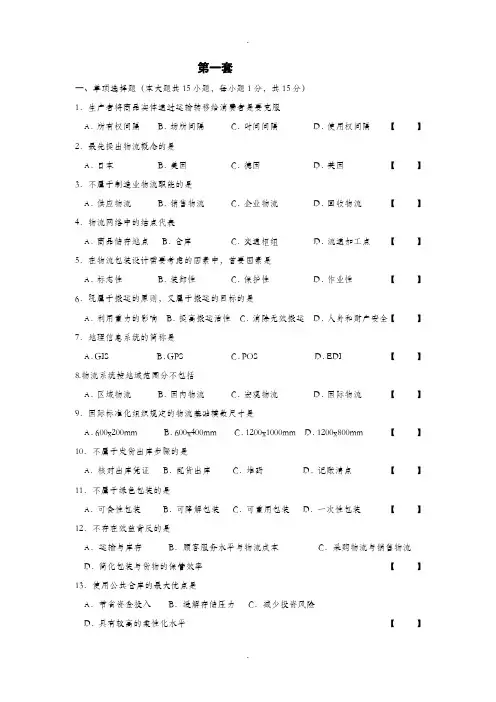
第一套一、单项选择题(本大题共15小题,每小题1分,共15分)1.生产者将商品实体通过运输转移给消费者是要克服A.所有权间隔B.场所间隔C.时间间隔D.使用权间隔【】2.最先提出物流概念的是A.日本B.美国C.德国D.英国【】3.不属于制造业物流职能的是A.供应物流B.销售物流C.企业物流D.回收物流【】4.物流网络中的结点代表A.商品储存地点B.仓库C.交通枢纽D.流通加工点【】5.在物流包装设计需要考虑的因素中,首要因素是A.标志性B.装卸性C.保护性D.作业性【】6.既属于搬运的原则,又属于搬运的目标的是A.利用重力的影响B.提高搬运活性C.消除无效搬运D.人身和财产安全【】7.地理信息系统的简称是A.GIS B.GPS C.POS D.EDI 【】8.物流系统按地域范围分不包括A.区域物流B.国内物流C.宏观物流D.国际物流【】9.国际标准化组织规定的物流基础模数尺寸是A.600x200mm B.600x400mm C.1200x1000mm D.1200x800mm 【】10.不属于发货出库步骤的是A.核对出库凭证B.配货出库C.堆码D.记账清点【】11.不属于绿色包装的是A.可食性包装B.可降解包装C.可重用包装D.一次性包装【】12.不存在效益背反的是A.运输与库存B.顾客服务水平与物流成本C.采购物流与销售物流D.简化包装与货物的保管效率【】13.使用公共仓库的最大优点是A.节省资金投入B.缓解存储压力C.减少投资风险D.具有较高的柔性化水平【】14.生产物流管理实践中尽力消除不增值活动和不必要环节的管理方法是A.TQC B.MRP C.JIT D.BPR 【】15.不属于衡量企业物流质量的主要因素的是A.物流时间B.物流成本C.物流效率D.物流网络【】一、多项选择题(本大题共5小题,每小题3分,共15分)16.目前国际上通用的和公认的物流条码码制有A.ITF-14 B.UCC/EAN-128 C.EAN-8D.ITF-13 E.EAN-13 【】17.人类社会生产与再生产的总过程分为A.生产B.分配C.交换D.消费E.物流【】18.基本物流服务主要包括A.运输B.保管C.包装D.装卸E.流通加工【】19.影响运输成本的因素包括A.距离B.装载量C.产品密度D.责任E.风险【】20.构成EDI系统的要素包括A.软件B.硬件C.通信网络D.数据标准化E.计算机人员【】二、名词解释题(本大题共5小题,每小题4分,共20分)21.物流22.配送中心23.搬运活性24.第三方物流25.流通加工三、简答题(本大题共5小题,每小题7分,共35分)26.什么是物流系统的效益背反?27.什么是物流冰山说?28.公路运输的特点是什么?29.不合理的储存现象有哪些?30.流通加工与生产加工有什么区别?四、论述题(本大题共1小题,每小题15分,共15分)31.请阐述物流服务与物流成本之间的关系,以及如何进行决策。
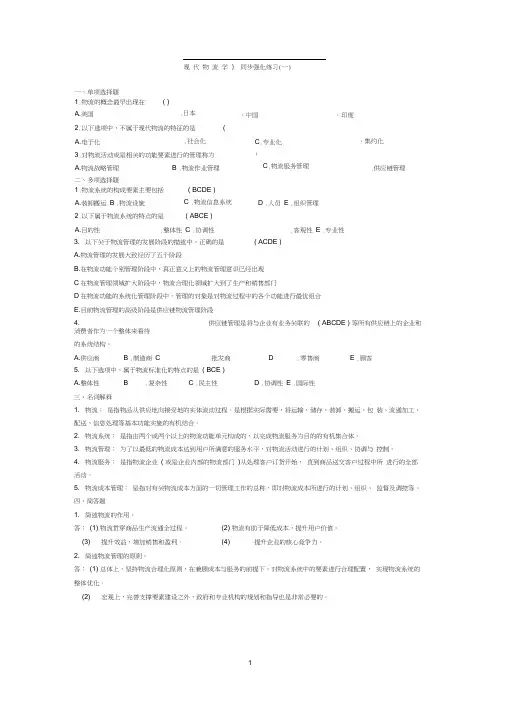
现 代 物 流 学 》 同步强化练习(一)一、单项选择题二、多项选择题3. 以下关于物流管理的发展阶段的描述中,正确的是 A.物流管理的发展大致经历了五个阶段B.在物流功能个别管理阶段中,真正意义上的物流管理意识已经出现 C 在物流管理领域扩大阶段中,物流合理化领域扩大到了生产和销售部门D 在物流功能的系统化管理阶段中,管理的对象是对物流过程中的各个功能进行最优组合 E.目前物流管理的高级阶段是供应链物流管理阶段 4.供应链管理是将与企业有业务关联的 ( ABCDE ) 等所有供应链上的企业和消费者作为一个整体来看待 的系统结构。
A.供应商 B .制造商 C .批发商 D .零售商 E .顾客5. 以下选项中,属于物流标准化的特点的是 ( BCE ) A.整体性B .复杂性C .民主性D .协调性E .国际性三、名词解释1. 物流: 是指物品从供应地向接受地的实体流动过程。
是根据实际需要,将运输、储存、装卸、搬运、包 装、流通加工、配送、信息处理等基本功能实施的有机结合。
2. 物流系统: 是指由两个或两个以上的物流功能单元构成的,以完成物流服务为目的的有机集合体。
3. 物流管理: 为了以最低的物流成本达到用户所满意的服务水平,对物流活动进行的计划、组织、协调与 控制。
4. 物流服务: 是指物流企业 ( 或是企业内部的物流部门 )从处理客户订货开始, 直到商品送交客户过程中所 进行的全部活动。
5. 物流成本管理: 是指对有关物流成本方面的一切管理工作的总称,即对物流成本所进行的计划、组织、 监督及调控等。
四、简答题1. 简述物流的作用。
答: (1) 物流贯穿商品生产流通全过程。
(2) 物流有助于降低成本,提升用户价值。
(3) 提升效益,增加销售和盈利。
(4)提升企业的核心竞争力。
2. 简述物流管理的原则。
答: (1) 总体上,坚持物流合理化原则,在兼顾成本与服务的前提下,对物流系统中的要素进行合理配置, 实现物流系统的整体优化。

第一套一、单项选择题(本大题共15小题,每小题1分,共15分)1.生产者将商品实体通过运输转移给消费者是要克服A.所有权间隔B.场所间隔C.时间间隔D.使用权间隔【】2.最先提出物流概念的是A.日本B.美国C.德国D.英国【】3.不属于制造业物流职能的是A.供应物流B.销售物流C.企业物流D.回收物流【】4.物流网络中的结点代表A.商品储存地点B.仓库C.交通枢纽D.流通加工点【】5.在物流包装设计需要考虑的因素中,首要因素是A.标志性B.装卸性C.保护性D.作业性【】6.既属于搬运的原则,又属于搬运的目标的是A.利用重力的影响B.提高搬运活性C.消除无效搬运D.人身和财产安全【】7.地理信息系统的简称是A.GIS B.GPS C.POS D.EDI 【】8.物流系统按地域范围分不包括A.区域物流B.国内物流C.宏观物流D.国际物流【】9.国际标准化组织规定的物流基础模数尺寸是A.600x200mm B.600x400mm C.1200x1000mm D.1200x800mm 【】10.不属于发货出库步骤的是A.核对出库凭证B.配货出库C.堆码D.记账清点【】11.不属于绿色包装的是A.可食性包装B.可降解包装C.可重用包装D.一次性包装【】12.不存在效益背反的是A.运输与库存B.顾客服务水平与物流成本C.采购物流与销售物流D.简化包装与货物的保管效率【】13.使用公共仓库的最大优点是A.节省资金投入B.缓解存储压力C.减少投资风险D.具有较高的柔性化水平【】14.生产物流管理实践中尽力消除不增值活动和不必要环节的管理方法是A.TQC B.MRP C.JIT D.BPR 【】15.不属于衡量企业物流质量的主要因素的是A.物流时间B.物流成本C.物流效率D.物流网络【】一、多项选择题(本大题共5小题,每小题3分,共15分)16.目前国际上通用的和公认的物流条码码制有A.ITF-14 B.UCC/EAN-128 C.EAN-8D.ITF-13 E.EAN-13 【】17.人类社会生产与再生产的总过程分为A.生产B.分配C.交换D.消费E.物流【】18.基本物流服务主要包括A.运输B.保管C.包装D.装卸E.流通加工【】19.影响运输成本的因素包括A.距离B.装载量C.产品密度D.责任E.风险【】20.构成EDI系统的要素包括A.软件B.硬件C.通信网络D.数据标准化E.计算机人员【】二、名词解释题(本大题共5小题,每小题4分,共20分)21.物流22.配送中心23.搬运活性24.第三方物流25.流通加工三、简答题(本大题共5小题,每小题7分,共35分)26.什么是物流系统的效益背反?27.什么是物流冰山说?28.公路运输的特点是什么?29.不合理的储存现象有哪些?30.流通加工与生产加工有什么区别?四、论述题(本大题共1小题,每小题15分,共15分)31.请阐述物流服务与物流成本之间的关系,以及如何进行决策。
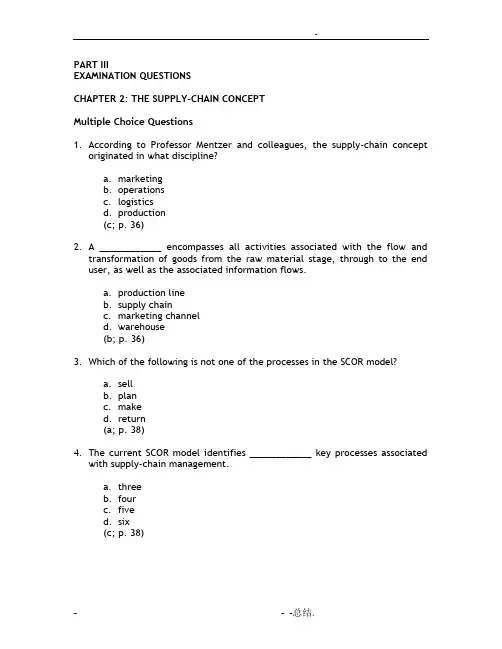
PART IIIEXAMINATION QUESTIONSCHAPTER 2: THE SUPPLY-CHAIN CONCEPTMultiple Choice Questions1.According to Professor Mentzer and colleagues, the supply-chain conceptoriginated in what discipline?a.marketingb.operationsc.logisticsd.production(c; p. 36)2. A ____________ encompasses all activities associated with the flow andtransformation of goods from the raw material stage, through to the end user, as well as the associated information flows.a.production lineb.supply chainc.marketing channeld.warehouse(b; p. 36)3.Which of the following is not one of the processes in the SCOR model?a.sellb.planc.maked.return(a; p. 38)4.The current SCOR model identifies ____________ key processes associatedwith supply-chain management.a.threeb.fourc.fived.six(c; p. 38)5.The text suggests that logistics has an important role in all SCOR processesexcept:a.makeb.sourcec.deliverd.plan(d; p. 38)6.It has been suggested that company-versus-company competition might besuperseded in the twenty-first century by:a.region-to-regionb.country-to-countryc.industry-to-industryd.supply chain-to-supply chain(d; p. 39)7.Which of the following are not key attributes of supply-chain management?a.inventory controlb.leveraging technologyc.customer powerd. a long-term orientatione.all are key attributes(e; p. 39)8.Contemporary supply chains should be fast and ____________.a.leanb.agilec.interactived.relevant(b; p. 40)9.An organization’s ability to respond to changes in demand with respect tovolume and variety refers to ____.a.responsivenessb.leannessc.agilityd.relevancy(c; p. 40)10.W hich of the following is not associated with relational exchanges?a.independenceb.trustmitmentd.shared benefits(a; p. 40)11.A ccording to the text, ____________ has been at the center of the changestaking place that affect the supply chain.a.logisticsb.warehousingc.technologyd.customer power(c; p. 41)12.W hat has been referred to as the greatest force of commodization known toman, for both goods and services?a.McDonald’sb.The Internetc.Wal-Martd.Logistics(b; p. 41)13.T he two key factors that have sparked much of the technological changeaffecting supply chains are ____________ and ____________.a.EDI, ERPputing power, ERPc.EDI, Internetputing power, Internet(d; p. 41)14.T he bullwhip effect:a.is an ineffective way to motivate warehouse employeesb.applies to rodeos and has nothing to do with supply-chainmanagementc.refers to the “swaying” motion associated with triple trailersd.refers to variability in demand orders among supply-chainparticipants(d; p. 42)15.W hich of the following is not a way to reduce inventory levels?a.supply-push replenishmentb.smaller, more frequent orderse of premium transportationd.elimination of slower moving products(a; p. 42)16.A supply-chain council:a.ensures that unfair trade practices don’t happen in supply ch ainsb.is comprised of all relevant CEOsc.meets periodically to evaluate supply-chain performanced.is a lobbying group concerned with promoting favorable supply-chainlegislation(c; p. 43)17.C ovisint, an on-line trading exchange, is an example of co-opetition in the____________ industry.a.fast-foodb.office supplyc.sporting goodsd.automotive(d; p. 44)18.W hich of the following is not a method of supply chain coordination?a.co-opetitionb.dovetailingc.placing personnel from one supply-chain participant into the facilityof another participantd.supply-chain councilse.all are methods(b; pp. 43–44)19.W hich of the following represents a method of supply chain coordination?a.dovetailingb.co-opetitionc.benchmarkingd.nesting(b; p. 44)20.W hich of the following is not a barrier to supply-chain management?a.regulatory and political considerationsck of top management commitmentc.reluctance to share, or use, relevant datad.incompatible corporate culturese.all are barriers(e; pp. 44–46)21.D ata mining:a.is illegal in the United Statesb.is synonymous with marginal analysisc.looks for patterns and relationships in relevant datad.can only be done by grocery stores(c; p. 45)22.L ooking for patterns and relationships in relevant data refers to:a.data warehousingb.marginal analysisc.correlation analysisd.data mining(d; p. 45)23.W hich of the following is false?a.ERP systems tend to be relatively strong when it comes to logisticsand supply chain requirements.b.Installing ERP systems can take several years to complete.c.ERP systems offer tremendous potential for increasing organizationaleffectiveness and efficiency.d.Installing ERP systems can be expensive.e.All of the above are true.(a; pp. 45–46)24.S upply chains can be integrated by having various parties enter into andcarry out long-term mutually beneficial agreements. These agreements are known by several names. Which of the following is not one of these names?a.partnershipsb.strategic alliancesc.third-party arrangementsd.contract logisticse.all of the above are correct(e; p. 46)25.T here are three primary methods that organizations can pursue whenattempting to integrate their supply chains. Which of the following is not one of them?a.vertical integrationb.intensive distributionc.formal contractsrmal agreements(b; p. 47)26.A ll of the following are factors that distinguish contemporary third-partylogistics from earlier efforts except:a.there tends to be a formal contract in contemporary 3PLb.contemporary 3PL focuses on customized offeringsc.contemporary 3PL has a transactional focusd.contemporary 3PL focuses on mutual benefits(c; p. 48)27.W hat is a fourth-party logistics provider?a. a third-party logistics provider that has been in existence for at least25 yearsb. a third-party logistics provider that has achieved ISO 9000certificationc. a logistics intermediary that specializes in one logistics activity (e.g.,transportation, warehousing)d. a general contractor that coordinates the activities of third-partylogistics providers(d; p. 49)28.W hich of the following statements about supply-chain software is false?a.many supply-chain software packages are developed for specific,rather than general, applicationsb.supply-chain software packages can focus on specific functionalactivities such as transportation and warehousingc.supply-chain software packages can focus on specific supply-chainprocesses such as customer relationship managementd.supply-chain software packages can attempt to simultaneouslyoptimize supply-chain processes across organizationse.all are true(a; pp. 49–50)29.T he supply-chain management philosophy emerged in which decade?a.1960sb.1970sc.1980sd.1990s(d; p. 36)30.A lthough nearly any organization can be part of a supply chain, supply-chainmanagement requires:a.the involvement of third-party logistics companiesb.overt management efforts by the organizations in a supply chainc.the participation of world-class organizationsd.at least one organization to be a multinational company(b; p. 37)31.A distinguishing feature of the JIT II concept is that:a.supplier and customer facilities are located in the same industrialparkb.only expedited transportation is usedpanies must have ISO 9000 certification to participated.suppliers have on-site offices at a particular customer(d; p. 39)32.W hat company developed the supplier integration program known as JIT II?a.Procter & Gambleb.Gapc.Bosed.McDonald’s(c; p. 39)33.C ontemporary supply chains should be agile and ____________.a.fastb.leanc.interactived.relevant(a; p. 40)34.W hich of the following is false?a.supply chains should employ a long-term orientationb.supply-chain management cannot be successful without informationsharingc.partnerships must involve formal, contractual agreementsd. a long-term orientation tends to be predicated on relationalexchanges(c; pp. 40–41)35.T he variability in demand orders among supply-chain participants:a.cannot be controlledb.refers to the bullwhip effectc.can be controlled with electronic order placementd.is more pronounced in relational exchanges(b; p. 42)True-False Questions1.The supply-chain concept originated in the logistics literature. (True, p. 36)2.Customers are not included as part of supply chains. (False, pp. 36–37)3.Supply-chain management requires overt management efforts by theorganizations within the supply chain. (True, p.37)4.The SCOR model identifies four key processes associated with supply-chainmanagement. (False, p. 38)5.JIT II is a supplier integration program that allows different suppliers tointeract with each other on a regular basis. (True, p. 39)6.Logistics has involvement in at least four of the key processes identified inthe SCOR model. (True, p. 38)7.Because customer needs and wants change relatively quickly, supply chainsshould be fast and lean. (False, p. 40)8.With respect to supply chains, relevancy focuses on an organization’s abilityto respond to changes in demand with respect to volume and variety. (False, p. 40)9.Supply chains should employ a long-term orientation with variousparticipants. (True, p. 40)10.F ormal partnerships are more likely than informal ones to result in improvedlong-term supply-chain performance. (True, p. 41)11.P ower retailers have been at the center of changes taking place that affectthe supply chain. (False, p. 41)12.T he Internet has been referred to as the greatest force of commodizationknown to man, for both goods and services. (True, p. 41)13.E nhanced communications across organizations in a supply chain is onlydependent on the technological capabilities of the organizations. (False, p.42)14.V ariability in demand orders among supply-chain participants is known asthe bubble effect. (False, p. 42)15.I nventory control in supply-chain management is attempting to move from“stops and starts” to continuous flow. (True, p. 42)16.S upply chain disruptions (e.g., delayed shipments) that occurred in thewake of the terrorist attacks in September 2001 have caused some supply chains to reassess their emphasis on inventory reduction. (True, p. 42)17.S upply-chain councils refer to lobbying groups concerned with promotingfavorable supply-chain legislation. (False, p. 43)18.C o-opetition is a concept that suggests that companies can be competitorsin some situations while working together in other situations. (True, p. 44) 19.C ovisint is an on-line trading exchange that represents an example of co-opetition in the grocery industry. (False, p. 44)20.R egulatory considerations present a bigger obstacle than politicalconsiderations to supply-chain management. (False, p. 44)21.T he overall global climate for business has shifted toward allowing morecooperation among firms—which should help supply-chain management.(True, p. 44)22.T op management is sometimes hesitant to fully commit to supply-chainmanagement. (True, p. 45)23.D ata warehousing is a technique that looks for patterns and relationships inthe relevant data. (False, p. 45)24.A lthough customer loyalty programs (e.g., frequent shopper cards) canprovide highly detailed data to companies, there are some who believe that these programs potentially violate a customer’s right to privacy. (True, p.45)25.M ost ERP systems tend to be relatively weak when it comes to logistics andsupply chain requirements. (True, p. 45)26.C orporate cultures should be an irrelevant consideration when designing asupply chain. (False, p. 46)27.A n individual firm can only be involved in one supply chain at a time. (False,p. 46)28.T he most common examples of vertical integration today are some lines ofpaint and automotive tires. (True, p. 47)29.I ntensive distribution is one of the methods that organizations can pursuewhen attempting to integrate their supply chains. (False, p. 47)rmal agreements offer supply-chain participants more flexibility thanother methods of supply-chain integration. (True, p. 47)31.C ontemporary third-party logistics has existed since about 1975. (False, p.48)32.C ontemporary third-party logistics tends to be characterized bystandardized, as opposed to customized, offerings. (False, p. 48)33.A fourth-party logistics provider should be viewed as a general contractorwhose primary purpose is to insure that third-party logistics providers are working toward relevant supply-chain goals. (True, p. 49)34.T he fourth-party logistics concept appears to be best suited to smallcompanies that need logistical assistance in only one or two functional areas. (False, p. 49)35.A s a general rule, supply-chain software packages look to coordinate andintegrate functions, processes, and/or systems across multiple supply-chain participants. (True, p. 50)。
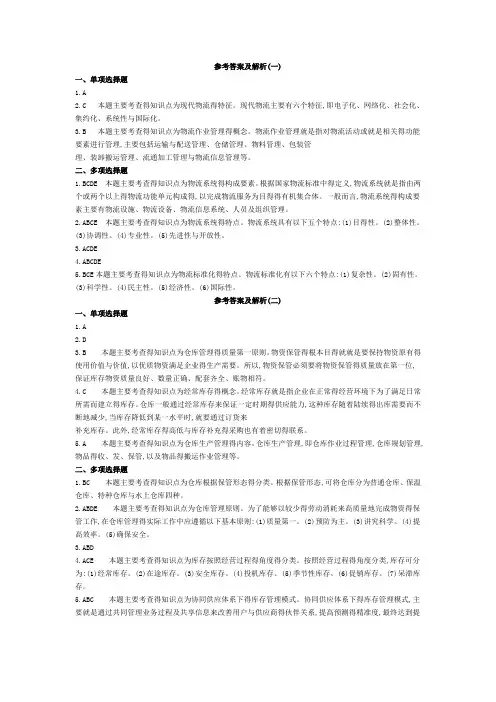
参考答案及解析(一)一、单项选择题1.A2.C 本题主要考查得知识点为现代物流得特征。
现代物流主要有六个特征,即电子化、网络化、社会化、集约化、系统性与国际化。
3.B 本题主要考查得知识点为物流作业管理得概念。
物流作业管理就是指对物流活动或就是相关得功能要素进行管理,主要包括运输与配送管理、仓储管理、物料管理、包装管理、装卸搬运管理、流通加工管理与物流信息管理等。
二、多项选择题1.BCDE 本题主要考查得知识点为物流系统得构成要素。
根据国家物流标准中得定义,物流系统就是指由两个或两个以上得物流功能单元构成得,以完成物流服务为目得得有机集合体。
一般而言,物流系统得构成要素主要有物流设施、物流设备、物流信息系统、人员及组织管理。
2.ABCE 本题主要考查得知识点为物流系统得特点。
物流系统具有以下五个特点:(1)目得性。
(2)整体性。
(3)协调性。
(4)专业性。
(5)先进性与开放性。
3.ACDE4.ABCDE5.BCE本题主要考查得知识点为物流标准化得特点。
物流标准化有以下六个特点:(1)复杂性。
(2)固有性。
(3)科学性。
(4)民主性。
(5)经济性。
(6)国际性。
参考答案及解析(二)一、单项选择题1.A2.D3.B 本题主要考查得知识点为仓库管理得质量第一原则。
物资保管得根本目得就就是要保持物资原有得使用价值与价值,以优质物资满足企业得生产需要。
所以,物资保管必须要将物资保管得质量放在第一位,保证库存物资质量良好、数量正确、配套齐全、账物相符。
4.C 本题主要考查得知识点为经常库存得概念。
经常库存就是指企业在正常得经营环境下为了满足日常所需而建立得库存。
仓库一般通过经常库存来保证一定时期得供应能力,这种库存随着陆续得出库需要而不断地减少,当库存降低到某一水平时,就要通过订货来补充库存。
此外,经常库存得高低与库存补充得采购也有着密切得联系。
5.A 本题主要考查得知识点为仓库生产管理得内容。
仓库生产管理,即仓库作业过程管理,仓库规划管理,物品得收、发、保管,以及物品得搬运作业管理等。
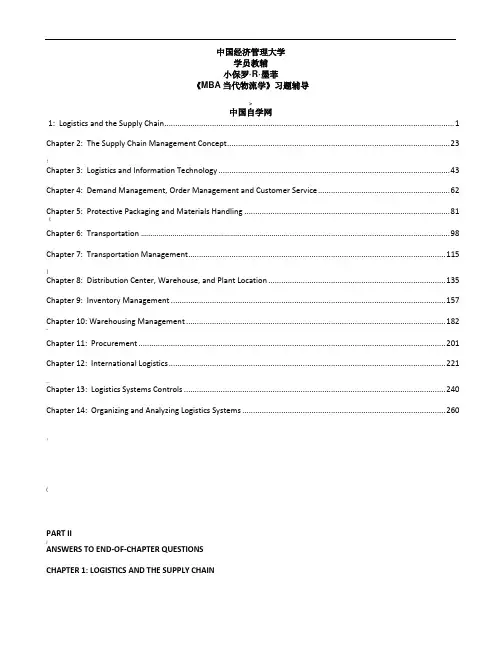
中国经济管理大学学员教辅小保罗·R·墨菲《MBA当代物流学》习题辅导>中国自学网1: Logistics and the Supply Chain (1)Chapter 2: The Supply Chain Management Concept (23)!Chapter 3: Logistics and Information Technology (43)Chapter 4: Demand Management, Order Management and Customer Service (62)Chapter 5: Protective Packaging and Materials Handling (81)《Chapter 6: Transportation (98)Chapter 7: Transportation Management (115)|Chapter 8: Distribution Center, Warehouse, and Plant Location (135)Chapter 9: Inventory Management (157)Chapter 10: Warehousing Management (182)-Chapter 11: Procurement (201)Chapter 12: International Logistics (221)…Chapter 13: Logistics Systems Controls (240)Chapter 14: Organizing and Analyzing Logistics Systems (260);(PART II;ANSWERS TO END-OF-CHAPTER QUESTIONSCHAPTER 1: LOGISTICS AND THE SUPPLY CHAIN1. Did it surprise you that logistics can be such an important component in a country’s economic system Why or why not它构成了一个国家至少10%的GDP、对于经济增长有很重要的作用The answer to this question likely depends on a student’s prior exposure to logistics. A “typical” student in an undergraduate basic logistics course likely has had limited exposure to and knowledge about logisticsand thus would likely be unaware as to logist ics’ impact on a country’s economic system. As such, she/hemight be pleasantly surprised to learn that logistics often accounts for at least 10% of a country’s GDP and also is important for economic growth and development.2.Distinguish between possession, form, time, and place utility.—Possession utility refers to the value or usefulness that comes from a customer being able to takepossession of a product and can be influenced by the relevant payment terms. Form utility refers to aproduct’s being in a form that (1) can be used by the customer and (2) is of value to the customer. Timeutility refers to having products available when they are needed by customers while place utility refers to having products available where they are needed by customers.3.How does logistics contribute to time and place utility时间效用:不同产品有不同的时间敏感度,香蕉和铅笔;地点效用:把产品从价至少的地方运到价值大的地方。
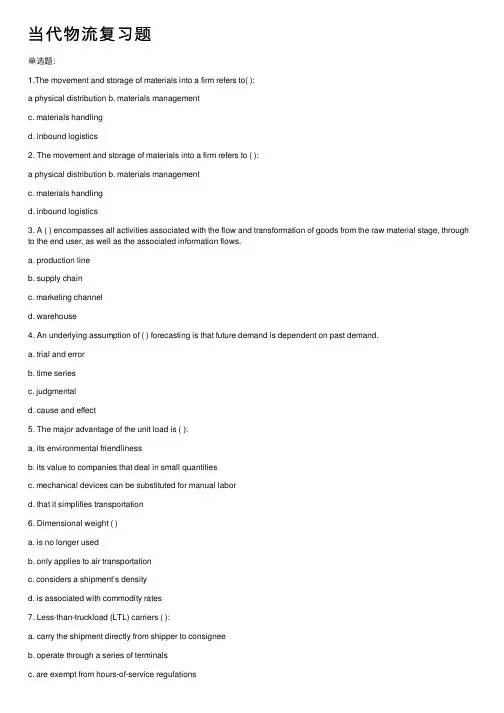
当代物流复习题单选题:1.The movement and storage of materials into a firm refers to( ):a physical distribution b. materials managementc. materials handlingd. inbound logistics2. The movement and storage of materials into a firm refers to ( ):a physical distribution b. materials managementc. materials handlingd. inbound logistics3. A ( ) encompasses all activities associated with the flow and transformation of goods from the raw material stage, through to the end user, as well as the associated information flows.a. production lineb. supply chainc. marketing channeld. warehouse4. An underlying assumption of ( ) forecasting is that future demand is dependent on past demand.a. trial and errorb. time seriesc. judgmentald. cause and effect5. The major advantage of the unit load is ( ):a. its environmental friendlinessb. its value to companies that deal in small quantitiesc. mechanical devices can be substituted for manual labord. that it simplifies transportation6. Dimensional weight ( )a. is no longer usedb. only applies to air transportationc. considers a shipment’s densityd. is associated with commodity rates7. Less-than-truckload (LTL) carriers ( ):a. carry the shipment directly from shipper to consigneeb. operate through a series of terminalsc. are exempt from hours-of-service regulationsd. serve only regional markets8. Studies have indicated that transportation managers can spend up to one-third of their time dealing with ( ) considerations.a. modal and carrier selectionb. international transportationc. documentationd. rate (pricing)9. A(n) ( ) rate simplifies each of the three primary rate factors—product, weight, and distance.a. classb. ad valoremc. commodityd. exception10. The most important single transportation document is the( ):a. bill of ladingb. freight billc. commercial invoiced. certificate of origin11. A pure material ( ):a. is one that loses no weight in manufacturingb. is soluble in waterc. cannot be mixed with other materialsd. comes from the ocean12. Inventory shrinkage ( ):a. is another name for inventory turnoverb. refers to the fact that more items are recorded entering than leaving warehousingfacilitiesc. refers to situations where the size and/or volume of inventory is decreased over timed. refers to a technique of stabilizing unit loads by using shrink wrap packaging13. Throughput refers to ( ):a. storage capacity of a warehousing facilityb. volume through a pipelinec. inventory turnover in a one-month periodd. amount of product entering and leaving a facility in a given time period14. ( ) refers to a process where a product is received in a facility, occasionally married with product going to the same destination, and then shipped at the earliest time, without going into longer-term storage.a. Just-in-timeb. Cross-dockingc. Consolidationd. Tailored logistics多选题:1.Which of the following are basic types of demand forecasting model?( )a. exponential smoothingb. cause and effectc. judgmentald. time series2. The commodities that suit to be transported by barge include :( )a. petroleumb. coalc. graind. forestry products3. ( ) which of the following about bill of lading are true?a. the bill of lading is the most important transportation documentb. the straight bill of lading contains the name of the consigneec. the order bill of lading does not contain the name of the consigneed. the bill of lading adds to the complexity of the transportation manager’s job4. The key factors influencing locational decisions are ( ).a. markets;b. resource availabilityc. labord. transport services;5. The EOQ deals with calculating the proper order size with respect to ( ).a. Ordering costb. Stockout costc. Carrying costd. Accounting cost6. ( ) are the component of inventory carrying cost.a. storage costb. insurance costc. shrinkage costd. interest cost7.Main types of regrouping function of warehousing include ( )a. Accumulatingb. Allocatingc. Assortingd. Sorting8. ( ) are the two assumption of using private warehouse in the supply chain.a. sufficient demand volumeb. bonded warehousingc. field warehousingd. stability of demand填空题1.Two of the prominent supply chain management models areand .2.Three functions of packaging are: 、and .3.Order cycle can be subdivided into four stages, they are: 、、and .4.is sometimes used interchangeably with customer satisfaction. 5. Customer service can be defined as the ability of logistic management to satisfy users in terms of: 、、and .6.Legal classification of for carrier includes: 、、and .7. If raw materials gain weight in processing, the finished products are called as .8. The biggest drawback to is the potential lack of control by the user.9.Four factors are used to determine a product’s freight classification they are : density, 、、and . 10.Three transportation documentation are: 、and 。

现代物流学考试题库及答案一、单项选择题1. 现代物流学中,物流的起点是()。
A. 供应B. 需求C. 运输D. 仓储答案:A2. 以下哪项不是物流的构成要素?()。
A. 运输B. 保管C. 信息D. 资金流答案:D3. 物流管理的最终目标是()。
A. 提高效率B. 降低成本C. 提高客户满意度D. 以上都是答案:D4. 物流系统的基本功能包括()。
A. 包装、装卸、运输、储存、流通加工、配送、信息处理B. 包装、装卸、运输、储存、配送、信息处理C. 包装、装卸、运输、储存、流通加工、配送、信息处理D. 包装、装卸、运输、储存、流通加工、配送答案:C5. 物流的“第三利润源”是指()。
A. 降低成本B. 提高效率C. 增加收入D. 提升服务答案:A二、多项选择题1. 现代物流的特点包括()。
A. 信息化B. 网络化C. 系统化D. 个性化答案:ABCD2. 物流成本包括以下哪些方面?()A. 运输成本B. 仓储成本C. 包装成本D. 信息处理成本答案:ABCD3. 物流服务的要素包括()。
A. 及时性B. 安全性C. 准确性D. 经济性答案:ABCD三、判断题1. 物流是供应链的一部分,但供应链不包括物流。
()答案:错误2. 物流的目的是实现商品从生产地到消费地的转移。
()答案:正确3. 物流管理只关注货物的流动,不涉及信息流和资金流的管理。
()答案:错误四、简答题1. 简述现代物流的发展趋势。
答案:现代物流的发展趋势包括全球化、信息化、绿色化、智能化和个性化。
全球化指的是物流服务范围的扩大,信息化指的是信息技术在物流领域的广泛应用,绿色化强调物流过程中的环保和节能,智能化指的是物流自动化和智能化技术的发展,个性化则是根据客户需求提供定制化的物流服务。
2. 描述物流管理的基本原则。
答案:物流管理的基本原则包括客户导向原则、系统化原则、成本效益原则、灵活性原则和创新原则。
客户导向原则强调以客户需求为中心,系统化原则要求物流活动作为一个整体进行管理,成本效益原则追求成本和效益的平衡,灵活性原则要求物流系统能够适应市场变化,创新原则鼓励在物流管理中采用新技术和新方法。
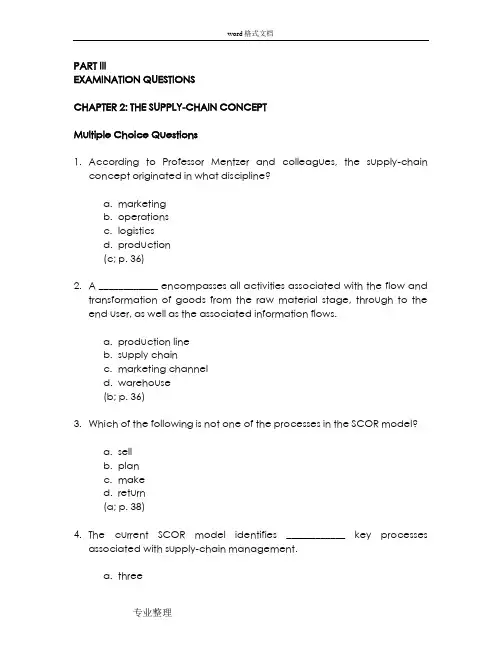
PART IIIEXAMINATION QUESTIONSCHAPTER 2: THE SUPPLY-CHAIN CONCEPTMultiple Choice Questions1.According to Professor Mentzer and colleagues, the supply-chainconcept originated in what discipline?a.marketingb.operationsc.logisticsd.production(c; p. 36)2. A ____________ encompasses all activities associated with the flow andtransformation of goods from the raw material stage, through to the end user, as well as the associated information flows.a.production lineb.supply chainc.marketing channeld.warehouse(b; p. 36)3.Which of the following is not one of the processes in the SCOR model?a.sellb.planc.maked.return(a; p. 38)4.The current SCOR model identifies ____________ key processesassociated with supply-chain management.a.threeb.fourc.fived.six (c; p. 38)5.The text suggests that logistics has an important role in all SCORprocesses except:a.makeb.sourcec.deliverd.plan(d; p. 38)6.It has been suggested that company-versus-company competitionmight be superseded in the twenty-first century by:a.region-to-regionb.country-to-countryc.industry-to-industryd.supply chain-to-supply chain(d; p. 39)7.Which of the following are not key attributes of supply-chainmanagement?a.inventory controlb.leveraging technologyc.customer powerd.a long-term orientatione.all are key attributes(e; p. 39)8.Contemporary supply chains should be fast and ____________.a.leanb.agilec.interactived.relevant(b; p. 40)9.An organization’s ability to respond to changes in demand withrespect to volume and variety refers to ____.a.responsivenessb.leannessc.agilityd.relevancy (c; p. 40)10.Which of the following is not associated with relational exchanges?a.independenceb.trustmitmentd.shared benefits(a; p. 40)11.According to the text, ____________ has been at the center of thechanges taking place that affect the supply chain.a.logisticsb.warehousingc.technologyd.customer power(c; p. 41)12.What has been referred to as the greatest force of commodizationknown to man, for both goods and services?a.McDonald’sb.The Internetc.Wal-Martd.Logistics(b; p. 41)13.The two key factors that have sparked much of the technologicalchange affecting supply chains are ____________ and ____________.a.EDI, ERPputing power, ERPc.EDI, Internetputing power, Internet(d; p. 41)14.The bullwhip effect:a.is an ineffective way to motivate warehouse employeesb.applies to rodeos and has nothing to do with supply-chainmanagementc.refers to the “swaying” motion associated with triple trailersd.refers to variability in demand orders among supply-chainparticipants(d; p. 42)15.Which of the following is not a way to reduce inventory levels?a.supply-push replenishmentb.smaller, more frequent orderse of premium transportationd.elimination of slower moving products(a; p. 42)16.A supply-chain council:a.ensures that unfair trade practices don’t happen in supplychainsb.is comprised of all relevant CEOsc.meets periodically to evaluate supply-chain performanced.is a lobbying group concerned with promoting favorable supply-chain legislation(c; p. 43)17.Covisint, an on-line trading exchange, is an example of co-opetition inthe ____________ industry.a.fast-foodb.office supplyc.sporting goodsd.automotive(d; p. 44)18.Which of the following is not a method of supply chain coordination?a.co-opetitionb.dovetailingc.placing personnel from one supply-chain participant into thefacility of another participantd.supply-chain councilse.all are methods(b; pp. 43–44)19.Which of the following represents a method of supply chaincoordination?a.dovetailingb.co-opetitionc.benchmarkingd.nesting(b; p. 44)20.Which of the following is not a barrier to supply-chain management?a.regulatory and political considerationsck of top management commitmentc.reluctance to share, or use, relevant datad.incompatible corporate culturese.all are barriers(e; pp. 44–46)21.Data mining:a.is illegal in the United Statesb.is synonymous with marginal analysisc.looks for patterns and relationships in relevant datad.can only be done by grocery stores(c; p. 45)22.Looking for patterns and relationships in relevant data refers to:a.data warehousingb.marginal analysisc.correlation analysisd.data mining(d; p. 45)23.Which of the following is false?a.ERP systems tend to be relatively strong when it comes to logisticsand supply chain requirements.b.Installing ERP systems can take several years to complete.c.ERP systems offer tremendous potential for increasingorganizational effectiveness and efficiency.d.Installing ERP systems can be expensive.e.All of the above are true.(a; pp. 45–46)24.Supply chains can be integrated by having various parties enter intoand carry out long-term mutually beneficial agreements. Theseagreements are known by several names. Which of the following is not one of these names?a.partnershipsb.strategic alliancesc.third-party arrangementsd.contract logisticse.all of the above are correct(e; p. 46)25.There are three primary methods that organizations can pursue whenattempting to integrate their supply chains. Which of the following is not one of them?a.vertical integrationb.intensive distributionc.formal contractsrmal agreements(b; p. 47)26.All of the following are factors that distinguish contemporary third-partylogistics from earlier efforts except:a.there tends to be a formal contract in contemporary 3PLb.contemporary 3PL focuses on customized offeringsc.contemporary 3PL has a transactional focusd.contemporary 3PL focuses on mutual benefits(c; p. 48)27.What is a fourth-party logistics provider?a.a third-party logistics provider that has been in existence for atleast 25 yearsb.a third-party logistics provider that has achieved ISO 9000certificationc.a logistics intermediary that specializes in one logistics activity(e.g., transportation, warehousing)d.a general contractor that coordinates the activities of third-partylogistics providers(d; p. 49)28.Which of the following statements about supply-chain software is false?a.many supply-chain software packages are developed forspecific, rather than general, applicationsb.supply-chain software packages can focus on specific functionalactivities such as transportation and warehousingc.supply-chain software packages can focus on specific supply-chain processes such as customer relationship managementd.supply-chain software packages can attempt to simultaneouslyoptimize supply-chain processes across organizationse.all are true(a; pp. 49–50)29.The supply-chain management philosophy emerged in which decade?a.1960sb.1970sc.1980sd.1990s(d; p. 36)30.Although nearly any organization can be part of a supply chain,supply-chain management requires:a.the involvement of third-party logistics companiesb.overt management efforts by the organizations in a supply chainc.the participation of world-class organizationsd.at least one organization to be a multinational company(b; p. 37)31.A distinguishing feature of the JIT II concept is that:a.supplier and customer facilities are located in the same industrialparkb.only expedited transportation is usedpanies must have ISO 9000 certification to participated.suppliers have on-site offices at a particular customer(d; p. 39)32.What company developed the supplier integration program known asJIT II?a.Procter & Gambleb.Gapc.Bosed.McDonald’s(c; p. 39)33.Contemporary supply chains should be agile and ____________.a.fastb.leanc.interactived.relevant (a; p. 40)34.Which of the following is false?a.supply chains should employ a long-term orientationb.supply-chain management cannot be successful withoutinformation sharingc.partnerships must involve formal, contractual agreementsd.a long-term orientation tends to be predicated on relationalexchanges(c; pp. 40–41)35.The variability in demand orders among supply-chain participants:a.cannot be controlledb.refers to the bullwhip effectc.can be controlled with electronic order placementd.is more pronounced in relational exchanges(b; p. 42)True-False Questions1.The supply-chain concept originated in the logistics literature. (True, p.36)2.Customers are not included as part of supply chains. (False, pp. 36–37)3.Supply-chain management requires overt management efforts by theorganizations within the supply chain. (True, p.37)4.The SCOR model identifies four key processes associated with supply-chain management. (False, p. 38)5.JIT II is a supplier integration program that allows different suppliers tointeract with each other on a regular basis. (True, p. 39)6.Logistics has involvement in at least four of the key processes identifiedin the SCOR model. (True, p. 38)7.Because customer needs and wants change relatively quickly, supplychains should be fast and lean. (False, p. 40)8.With respect to supply chains, relevancy focuses on an organization’sability to respond to changes in demand with respect to volume and variety. (False, p. 40)9.Supply chains should employ a long-term orientation with variousparticipants. (True, p. 40)10.Formal partnerships are more likely than informal ones to result inimproved long-term supply-chain performance. (True, p. 41)11.Power retailers have been at the center of changes taking place thataffect the supply chain. (False, p. 41)12.The Internet has been referred to as the greatest force ofcommodization known to man, for both goods and services. (True, p. 41) 13.Enhanced communications across organizations in a supply chain isonly dependent on the technological capabilities of the organizations.(False, p. 42)14.Variability in demand orders among supply-chain participants is knownas the bubble effect. (False, p. 42)15.Inventory control in supply-chain management is attempting to movefrom “stops and starts” to continuous flow. (True, p. 42)16.Supply chain disruptions (e.g., delayed shipments) that occurred in thewake of the terrorist attacks in September 2001 have caused some supply chains to reassess their emphasis on inventory reduction. (True, p.42)17.Supply-chain councils refer to lobbying groups concerned withpromoting favorable supply-chain legislation. (False, p. 43)18.Co-opetition is a concept that suggests that companies can becompetitors in some situations while working together in other situations.(True, p. 44)19.Covisint is an on-line trading exchange that represents an example ofco-opetition in the grocery industry. (False, p. 44)20.Regulatory considerations present a bigger obstacle than politicalconsiderations to supply-chain management. (False, p. 44)21.The overall global climate for business has shifted toward allowing morecooperation among firms—which should help supply-chain management. (True, p. 44)22.Top management is sometimes hesitant to fully commit to supply-chainmanagement. (True, p. 45)23.Data warehousing is a technique that looks for patterns andrelationships in the relevant data. (False, p. 45)24.Although customer loyalty programs (e.g., frequent shopper cards) canprovide highly detailed data to companies, there are some who believe that these programs potentially violate a customer’s right to privacy. (True, p. 45)25.Most ERP systems tend to be relatively weak when it comes to logisticsand supply chain requirements. (True, p. 45)26.Corporate cultures should be an irrelevant consideration whendesigning a supply chain. (False, p. 46)27.An individual firm can only be involved in one supply chain at a time.(False, p. 46)28.The most common examples of vertical integration today are somelines of paint and automotive tires. (True, p. 47)29.Intensive distribution is one of the methods that organizations canpursue when attempting to integrate their supply chains. (False, p. 47)30. Informal agreements offer supply-chain participants more flexibilitythan other methods of supply-chain integration. (True, p. 47)31.Contemporary third-party logistics has existed since about 1975. (False,p. 48)32.Contemporary third-party logistics tends to be characterized bystandardized, as opposed to customized, offerings. (False, p. 48)33.A fourth-party logistics provider should be viewed as a generalcontractor whose primary purpose is to insure that third-party logistics providers are working toward relevant supply-chain goals. (True, p. 49) 34.The fourth-party logistics concept appears to be best suited to smallcompanies that need logistical assistance in only one or two functional areas. (False, p. 49)35.As a general rule, supply-chain software packages look to coordinateand integrate functions, processes, and/or systems across multiple supply-chain participants. (True, p. 50)。
现代物流学练习题及答案一、单选1.不属于衡量企业物流质量的主要因素是( D )。
A.物流时间B.物流成本C.物流效率D.物流网络2.库存管理得好,新产品的开发时间会缩短( C )。
A.1/3B.1/2C.2/3D.3/53.电子商务的一个重要特征是( A )。
A.网络化B.自动化C.智能化D.集成化4.在运输中收货人通常是合同当中的( C )。
A.第一方B.第二方C.第三方D.以上皆不是5.物流企业是为( D )提供服务的。
A.企业B.生产商C.中间商D.社会用户6.下列那一项关于ABC管理的叙述是正确的( D )。
A.A类占整个销售的60%,B类20%,C类占20%B.A类占整个销售的70%,B类20%,C类占10%C.A类占整个销售的80%,B类10%,C类占10%D.A类占整个销售的80%,B类适中,C类占20%7.最先提出物流概念的是( B )。
A.日本B.美国C.德国D.法国8.物流业务的中心活动是( C )。
A.配送B.装卸C.运输D.储存9.物流的生产和发展是( C )的需要,是流通的主要因素。
A.社会经济发展B.运输业C.社会再生产D.流通加工发展10.下列不属于制造业物流的是( C )。
A.供应物流B.销售物流C.企业物流D.回收物流11.生产者将商品实体通过运输转移给消费者是要克服( C )。
A.所有权间隔B.使用权间隔C.场所间隔D.时间间隔12.地理信息系统的简称是( A )。
A.GISB.GPSC.POSD.EDI13. 包装的首要功能是( A )。
A.保护货物B. 便于处理C.促进销售D.美观大方14.下列哪项运输方式主要用于运输天然气、原油或成品油。
( C )A.铁路运输B.公路运输C.管道运输D.水路运输15.下列那一项是物流企业用于交换商业文件的标准形式( C )。
A.DIFB.EIFC.EDID.DEF16.下列关于最佳包装设计表述最正确的是( C )。
A.符合现代顾客的审美观,以顾客为导向的包装设计B.以成本为导向,尽量节省成本,从而提高经济效益C.用最少的费用获得最大的经济效益D.最佳包装设计是能够使产品价值最大化的包装设计17.下列哪一项是拟定配送计划的主要依据( B )。
物流管理专业本科《现代物流学》单元练习题第一章现代物流学概论一、不定项选择题1.有形物品的通称为()。
A.物品B.物料C.商品D.物资E.货物2.()是生产领域的一个专门概念。
A.物资B.物料C.货物D.物品3.下列术语中,()是交通运输领域中的一个专门概念。
A.物资B.物料C.货物D.物品4.狭义的物流仅只作为()的物质资料在生产者与消费者之间发生的空间运动过程。
A.商品B.产品C.原料D.材料5.现代物流着重于将物流与供应链的其他环节进行集成,这成为现代物流在运作上呈现多样化特征的()。
A.功能集成化B.反应快速化C.服务系列化D.作业规范化6.现代物流在运作上呈现多样化特征,表现在()。
A.功能集成化B.反应快速化C.服务系列化D.作业规范化E.目标系列化⑥手段现代化⑦经营市场化⑧组织网络化7.物流服务提供者对上游、下游的物流、配送需求的反应速度越来越快,配送间隔越来越短,商品周转次数越来越多,这反应了现代物流在运作上呈现的()。
4A.反应快速化的特征B.功能集成化的特征C.服务系列化的特征D.组织网络化的特征8.现代物流着重于将物流与供应链的其他环节进行集成,称为()。
A.经营市场化B.反应快速化C.功能集成化D.服务系列化9.现代物流着重于将物流与供应链的其他环节进行集成,这称为现代物流在运作上呈现多样化特征的()。
A.功能集成化B.反应快速化C.服务系列化D.作业规范化()10.除了传统的储存、运输、包装、流通加工等服务外,现代物流服务在外延上向上扩展到市场调查与预测、采购及定单处理,向下延伸至配送、货款回收与结算等,这成为现代物流在运作上呈现多样化特征的()。
A.功能集成化B.经营市场化C.服务系列化D.目标系列化11.现代物流无论是企业自己组织物流,还是委托社会化物流企业承担物流服务,都以“服务—成本”的最佳组合为总目标,体现现代物流在运作上呈现出()的特征。
A.功能集成化B.经营市场化C.服务系列化D.作业规范化12.规范的作业标准和服务标准称为()。
现代物流学试题三及答案一、选择题(每题2分,共20分)下列各题A、B、C、D四个选项中,只有一个选项是正确的,请将正确的选项涂写在答题卡相应位置上,答在试卷上不得分。
1.对象物所有权转移的活动称之为(),而()是实物从供给方向需求方的转移,二者共同构成了流通的主要内容。
A.资金流,信息流 B.商流,物流C.信息流,资金流 D.物流,商流2.物流系统设计的核心是()。
A.概略设计 B.系统分析 C.方案确定 D.详细设计3.在下列运输方式中,运量相对较大的是()。
A.水路运输 B.陆路运输 C.航空运输 D.管道运输4.反映物流各种活动内容的知识、资料、图象、数据、文件的总称称为()。
A.物流情报 B.物流集合 C.物流汇编 D.物流信息5.日本早稻田大学西泽修教授将物流成本的隐含性描述为()。
A.物流成本死海说 B.物流成本冰山说C.物流成本陆地说 D.物流成本暗箱说6.应用最广泛的叉车是()。
A.平衡重式叉车 B.插腿式叉车 C.内燃式叉车 D.前移式叉车7.就物流系统而言,()是保证整个物流系统正常运作的关键,是物流系统的“心脏”。
A.集装化器具标准 B.物流设施标准C.物流信息管理系统 D.基础标准8.供应链是()结构。
A.直链 B.网链 C.支链 D.环状9.企业利用第三方物流,可使企业专注于提高()。
A.核心竞争力 B.经济效益 C.社会价值 D.社会效益10.各种物流服务的基本功能,特别是运输、仓储、信息集成、存货管理、订单处理、物料采购等功能最可能成为增值服务延伸的()。
A.核心 B.起点 C.终点 D.加油站二、简答题(每题5分,共40分)1.简述物流系统分析的作用和原则。
2.简述物流战略的概念和内容?3.简述包装的功能以及实现包装合理化的途径?4.国际物流的主要运作活动有哪些?5.如何实施有效的供应链管理?6.我国第四方物流运营应采取什么样的模式?7.国外发达国家物流产业发展政策对我国有哪些借鉴?8.简述绿色物流系统的特征?三、论述题(每题10分,共20分)1.物流管理组织结构的基本形态有哪几种?并论述各自的特点?2.仓储管理的任务是什么?如何实现仓储的合理化?四、案例题(每题20分,共20分)物流的概念自80年代传入我国以来,经过政府有关部门、研究机构及广大企业大力宣传和倡导,已逐渐走出象牙塔,成为大众的热门话题。
《现代物流学》同步强化练习(一)一、单项选择题1.物流的概念最早出现在( )A.美国 B.日本 C.中国 D.印度2.以下选项中,不属于现代物流的特征的是 ( )A.电子化 B.社会化C.专业化 D.集约化3.对物流活动或是相关的功能要素进行的管理称为( )A.物流战略管理 B.物流作业管理C.物流服务管理 D.供应链管理二、多项选择题1.物流系统的构成要素主要包括 ( BCDE )A.装卸搬运 B.物流设施 C.物流信息系统 D.人员 E.组织管理2.以下属于物流系统的特点的是( ABCE )A.目的性 B.整体性 C.协调性 D.客观性 E.专业性3.以下关于物流管理的发展阶段的描述中,正确的是( ACDE )A.物流管理的发展大致经历了五个阶段B.在物流功能个别管理阶段中,真正意义上的物流管理意识已经出现C.在物流管理领域扩大阶段中,物流合理化领域扩大到了生产和销售部门D.在物流功能的系统化管理阶段中,管理的对象是对物流过程中的各个功能进行最优组合E.目前物流管理的高级阶段是供应链物流管理阶段4.供应链管理是将与企业有业务关联的( ABCDE )等所有供应链上的企业和消费者作为一个整体来看待的系统结构。
A.供应商 B.制造商 C.批发商 D.零售商 E.顾客5.以下选项中,属于物流标准化的特点的是( BCE )A.整体性 B.复杂性 C.民主性 D.协调性 E.国际性三、名词解释1.物流:是指物品从供应地向接受地的实体流动过程。
是根据实际需要,将运输、储存、装卸、搬运、包装、流通加工、配送、信息处理等基本功能实施的有机结合。
2.物流系统:是指由两个或两个以上的物流功能单元构成的,以完成物流服务为目的的有机集合体。
3.物流管理:为了以最低的物流成本达到用户所满意的服务水平,对物流活动进行的计划、组织、协调与控制。
4.物流服务:是指物流企业(或是企业内部的物流部门)从处理客户订货开始,直到商品送交客户过程中所进行的全部活动。
单选题:1.The movement and storage of materials into a firm refers to( ):a physical distribution b. materials managementc. materials handlingd. inbound logistics2. The movement and storage of materials into a firm refers to ( ):a physical distribution b. materials managementc. materials handlingd. inbound logistics3. A ( ) encompasses all activities associated with the flow and transformation of goods from the raw material stage, through to the end user, as well as the associated information flows.a. production lineb. supply chainc. marketing channeld. warehouse4. An underlying assumption of ( ) forecasting is that future demand is dependent on past demand.a. trial and errorb. time seriesc. judgmentald. cause and effect5. The major advantage of the unit load is ( ):a. its environmental friendlinessb. its value to companies that deal in small quantitiesc. mechanical devices can be substituted for manual labord. that it simplifies transportation6. Dimensional weight ( )a. is no longer usedb. only applies to air transportationc. considers a shipment’s densityd. is associated with commodity rates7. Less-than-truckload (LTL) carriers ( ):a. carry the shipment directly from shipper to consigneeb. operate through a series of terminalsc. are exempt from hours-of-service regulationsd. serve only regional markets8. Studies have indicated that transportation managers can spend up to one-third of their time dealing with ( ) considerations.a. modal and carrier selectionb. international transportationc. documentationd. rate (pricing)9. A(n) ( ) rate simplifies each of the three primary rate factors—product, weight, and distance.a. classb. ad valoremc. commodityd. exception10. The most important single transportation document is the( ):a. bill of ladingb. freight billc. commercial invoiced. certificate of origin11. A pure material ( ):a. is one that loses no weight in manufacturingb. is soluble in waterc. cannot be mixed with other materialsd. comes from the ocean12. Inventory shrinkage ( ):a. is another name for inventory turnoverb. refers to the fact that more items are recorded entering than leaving warehousingfacilitiesc. refers to situations where the size and/or volume of inventory is decreased over timed. refers to a technique of stabilizing unit loads by using shrink wrap packaging13. Throughput refers to ( ):a. storage capacity of a warehousing facilityb. volume through a pipelinec. inventory turnover in a one-month periodd. amount of product entering and leaving a facility in a given time period14. ( ) refers to a process where a product is received in a facility, occasionally married with product going to the same destination, and then shipped at the earliest time, without going into longer-term storage.a. Just-in-timeb. Cross-dockingc. Consolidationd. Tailored logistics多选题:1.Which of the following are basic types of demand forecasting model?( )a. exponential smoothingb. cause and effectc. judgmentald. time series2. The commodities that suit to be transported by barge include :( )a. petroleumb. coalc. graind. forestry products3. ( ) which of the following about bill of lading are true?a. the bill of lading is the most important transportation documentb. the straight bill of lading contains the name of the consigneec. the order bill of lading does not contain the name of the consigneed. the bill of lading adds to the complexity of the transportation manager’s job4. The key factors influencing locational decisions are ( ).a. markets;b. resource availabilityc. labord. transport services;5. The EOQ deals with calculating the proper order size with respect to ( ).a. Ordering costb. Stockout costc. Carrying costd. Accounting cost6. ( ) are the component of inventory carrying cost.a. storage costb. insurance costc. shrinkage costd. interest cost7.Main types of regrouping function of warehousing include ( )a. Accumulatingb. Allocatingc. Assortingd. Sorting8. ( ) are the two assumption of using private warehouse in the supply chain.a. sufficient demand volumeb. bonded warehousingc. field warehousingd. stability of demand填空题1.Two of the prominent supply chain management models areand .2.Three functions of packaging are: 、and .3.Order cycle can be subdivided into four stages, they are: 、、and .4.is sometimes used interchangeably with customer satisfaction. 5. Customer service can be defined as the ability of logistic management to satisfy users in terms of: 、、and .6.Legal classification of for carrier includes: 、、and .7. If raw materials gain weight in processing, the finished products are called as .8. The biggest drawback to is the potential lack of control by the user.9.Four factors are used to determine a product’s freight classification they are : density, 、、and . 10.Three transportation documentation are: 、and 。
当代物流学习题3标准化文件发布号:(9312-EUATWW-MWUB-WUNN-INNUL-DQQTY-PART IIIEXAMINATION QUESTIONSCHAPTER 2: THE SUPPLY-CHAIN CONCEPTMultiple Choice Questions1.According to Professor Mentzer and colleagues, the supply-chain concept originatedin what disciplinea.marketingb.operationsc.logisticsd.production(c; p. 36)2. A ____________ encompasses all activities associated with the flow andtransformation of goods from the raw material stage, through to the end user, as well as the associated information flows.a.production lineb.supply chainc.marketing channeld.warehouse(b; p. 36)3.Which of the following is not one of the processes in the SCOR modela.sellb.planc.maked.return(a; p. 38)4.The current SCOR model identifies ____________ key processes associated withsupply-chain management.a.threeb.fourc.fived.six(c; p. 38)5.The text suggests that logistics has an important role in all SCOR processes except:a.makeb.sourcec.deliverd.plan(d; p. 38)6.It has been suggested that company-versus-company competition might besuperseded in the twenty-first century by:a.region-to-regionb.country-to-countryc.industry-to-industryd.supply chain-to-supply chain(d; p. 39)7.Which of the following are not key attributes of supply-chain managementa.inventory controlb.leveraging technologyc.customer powerd. a long-term orientatione.all are key attributes(e; p. 39)8.Contemporary supply chains should be fast and ____________.a.leanb.agilec.interactived.relevant(b; p. 40)9.An organization’s ability to respond to changes in demand with respect to volumeand variety refers to ____.a.responsivenessb.leannessc.agilityd.relevancy(c; p. 40)10.Which of the following is not associated with relational exchangesa.independenceb.trustmitmentd.shared benefits(a; p. 40)11.According to the text, ____________ has been at the center of the changes takingplace that affect the supply chain.a.logisticsb.warehousingc.technologyd.customer power(c; p. 41)12.What has been referred to as the greatest force of commodization known to man,for both goods and servicesa.McDonald’sb.The Internetc.Wal-Martd.Logistics(b; p. 41)13.The two key factors that have sparked much of the technological change affectingsupply chains are ____________ and ____________.a.EDI, ERPputing power, ERPc.EDI, Internetputing power, Internet(d; p. 41)14.The bullwhip effect:a.is an ineffective way to motivate warehouse employeesb.applies to rodeos and has nothing to do with supply-chain managementc.refers to the “swaying” motion associated with triple trailersd.refers to variability in demand orders among supply-chain participants(d; p. 42)15.Which of the following is not a way to reduce inventory levelsa.supply-push replenishmentb.smaller, more frequent orderse of premium transportationd.elimination of slower moving products(a; p. 42)16.A supply-chain council:a.ensures that unfair trade practices don’t happen in supply chainsb.is comprised of all relevant CEOsc.meets periodically to evaluate supply-chain performanced.is a lobbying group concerned with promoting favorable supply-chainlegislation(c; p. 43)17.Covisint, an on-line trading exchange, is an example of co-opetition in the____________ industry.a.fast-foodb.office supplyc.sporting goodsd.automotive(d; p. 44)18.Which of the following is not a method of supply chain coordinationa.co-opetitionb.dovetailingc.placing personnel from one supply-chain participant into the facility ofanother participantd.supply-chain councilse.all are methods(b; pp. 43–44)19.Which of the following represents a method of supply chain coordinationa.dovetailingb.co-opetitionc.benchmarkingd.nesting(b; p. 44)20.Which of the following is not a barrier to supply-chain managementa.regulatory and political considerationsck of top management commitmentc.reluctance to share, or use, relevant datad.incompatible corporate culturese.all are barriers(e; pp. 44–46)21.Data mining:a.is illegal in the United Statesb.is synonymous with marginal analysisc.looks for patterns and relationships in relevant datad.can only be done by grocery stores(c; p. 45)22.Looking for patterns and relationships in relevant data refers to:a.data warehousingb.marginal analysisc.correlation analysisd.data mining(d; p. 45)23.Which of the following is falsea.ERP systems tend to be relatively strong when it comes to logistics andsupply chain requirements.b.Installing ERP systems can take several years to complete.c.ERP systems offer tremendous potential for increasing organizationaleffectiveness and efficiency.d.Installing ERP systems can be expensive.e.All of the above are true.(a; pp. 45–46)24.Supply chains can be integrated by having various parties enter into and carry outlong-term mutually beneficial agreements. These agreements are known by several names. Which of the following is not one of these namesa.partnershipsb.strategic alliancesc.third-party arrangementsd.contract logisticse.all of the above are correct(e; p. 46)25.There are three primary methods that organizations can pursue when attempting tointegrate their supply chains. Which of the following is not one of thema.vertical integrationb.intensive distributionc.formal contractsrmal agreements(b; p. 47)26.All of the following are factors that distinguish contemporary third-party logisticsfrom earlier efforts except:a.there tends to be a formal contract in contemporary 3PLb.contemporary 3PL focuses on customized offeringsc.contemporary 3PL has a transactional focusd.contemporary 3PL focuses on mutual benefits(c; p. 48)27.What is a fourth-party logistics providera. a third-party logistics provider that has been in existence for at least 25 yearsb. a third-party logistics provider that has achieved ISO 9000 certificationc. a logistics intermediary that specializes in one logistics activity .,transportation, warehousing)d. a general contractor that coordinates the activities of third-party logisticsproviders(d; p. 49)28.Which of the following statements about supply-chain software is falsea.many supply-chain software packages are developed for specific, rather thangeneral, applicationsb.supply-chain software packages can focus on specific functional activitiessuch as transportation and warehousingc.supply-chain software packages can focus on specific supply-chain processessuch as customer relationship managementd.supply-chain software packages can attempt to simultaneously optimizesupply-chain processes across organizationse.all are true(a; pp. 49–50)29.The supply-chain management philosophy emerged in which decadea.1960sb.1970sc.1980sd.1990s(d; p. 36)30.Although nearly any organization can be part of a supply chain, supply-chainmanagement requires:a.the involvement of third-party logistics companiesb.overt management efforts by the organizations in a supply chainc.the participation of world-class organizationsd.at least one organization to be a multinational company(b; p. 37)31.A distinguishing feature of the JIT II concept is that:a.supplier and customer facilities are located in the same industrial parkb.only expedited transportation is usedpanies must have ISO 9000 certification to participated.suppliers have on-site offices at a particular customer(d; p. 39)32.What company developed the supplier integration program known as JIT IIa.Procter & Gambleb.Gapc.Bosed.McDonald’s(c; p. 39)33.Contemporary supply chains should be agile and ____________.a.fastb.leanc.interactived.relevant(a; p. 40)34.Which of the following is falsea.supply chains should employ a long-term orientationb.supply-chain management cannot be successful without information sharingc.partnerships must involve formal, contractual agreementsd. a long-term orientation tends to be predicated on relational exchanges(c; pp. 40–41)35.The variability in demand orders among supply-chain participants:a.cannot be controlledb.refers to the bullwhip effectc.can be controlled with electronic order placementd.is more pronounced in relational exchanges(b; p. 42)True-False Questions1.The supply-chain concept originated in the logistics literature. (True, p. 36)2.Customers are not included as part of supply chains. (False, pp. 36–37)3.Supply-chain management requires overt management efforts by the organizationswithin the supply chain. (True,4.The SCOR model identifies four key processes associated with supply-chainmanagement. (False, p. 38)5.JIT II is a supplier integration program that allows different suppliers to interact witheach other on a regular basis. (True, p. 39)6.Logistics has involvement in at least four of the key processes identified in the SCORmodel. (True, p. 38)7.Because customer needs and wants change relatively quickly, supply chains shouldbe fast and lean. (False, p. 40)8.With respect to supply chains, relevancy focuses on an organization’s ability torespond to changes in demand with respect to volume and variety. (False, p. 40)9.Supply chains should employ a long-term orientation with various participants. (True,p. 40)10.Formal partnerships are more likely than informal ones to result in improved long-term supply-chain performance. (True, p. 41)11.Power retailers have been at the center of changes taking place that affect thesupply chain. (False, p. 41)12.The Internet has been referred to as the greatest force of commodization known toman, for both goods and services. (True, p. 41)13.Enhanced communications across organizations in a supply chain is only dependenton the technological capabilities of the organizations. (False, p. 42)14.Variability in demand orders among supply-chain participants is known as the bubbleeffect. (False, p. 42)15.Inventory control in supply-chain management is attempting to move from “stopsand starts” to continuous flow. (True, p. 42)16.Supply chain disruptions ., delayed shipments) that occurred in the wake of theterrorist attacks in September 2001 have caused some supply chains to reassess their emphasis on inventory reduction. (True, p. 42)17.Supply-chain councils refer to lobbying groups concerned with promoting favorablesupply-chain legislation. (False, p. 43)18.Co-opetition is a concept that suggests that companies can be competitors in somesituations while working together in other situations. (True, p. 44)19.Covisint is an on-line trading exchange that represents an example of co-opetition inthe grocery industry. (False, p. 44)20.Regulatory considerations present a bigger obstacle than political considerations tosupply-chain management. (False, p. 44)21.The overall global climate for business has shifted toward allowing morecooperation among firms—which should help supply-chain management. (True, p.44)22.Top management is sometimes hesitant to fully commit to supply-chainmanagement. (True, p. 45)23.Data warehousing is a technique that looks for patterns and relationships in therelevant data. (False, p. 45)24.Although customer loyalty programs ., frequent shopper cards) can provide highlydetailed data to companies, there are some who believe that these programs potentially violate a customer’s right to privacy. (True, p. 45)25.Most ERP systems tend to be relatively weak when it comes to logistics and supplychain requirements. (True, p. 45)26.Corporate cultures should be an irrelevant consideration when designing a supplychain. (False, p. 46)27.An individual firm can only be involved in one supply chain at a time. (False, p. 46)28.The most common examples of vertical integration today are some lines of paint andautomotive tires. (True, p. 47)29.Intensive distribution is one of the methods that organizations can pursue whenattempting to integrate their supply chains. (False, p. 47)30. Informal agreements offer supply-chain participants more flexibility than othermethods of supply-chain integration. (True, p. 47)31.Contemporary third-party logistics has existed since about 1975. (False, p. 48)32.Contemporary third-party logistics tends to be characterized by standardized, asopposed to customized, offerings. (False, p. 48)33.A fourth-party logistics provider should be viewed as a general contractor whoseprimary purpose is to insure that third-party logistics providers are working toward relevant supply-chain goals. (True, p. 49)34.The fourth-party logistics concept appears to be best suited to small companies thatneed logistical assistance in only one or two functional areas. (False, p. 49)35.As a general rule, supply-chain software packages look to coordinate and integratefunctions, processes, and/or systems across multiple supply-chain participants. (True, p. 50)。